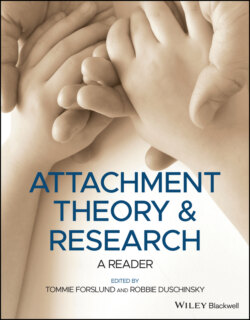Читать книгу Attachment Theory and Research - Группа авторов - Страница 19
Appendix: Appendix
ОглавлениеIn a passage in Beyond the Pleasure Principle (1920, p. 12) Freud seeks to differentiate between the conditions denoted respectively by the German words ‘Schreck’, ‘Furcht’, and ‘Angst’, namely ‘fright’, ‘fear’, and ‘anxiety’: ‘“Anxiety” describes a particular state of expecting the danger or preparing for it, even though it may be an unknown one. “Fear” requires a definite object of which to be afraid. “Fright”, however, is the name we give to the state a person gets into when he has run into danger without being prepared for it; it emphasizes the factor of surprise.’ As we have seen, six years later in Inhibitions, Symptoms and Anxiety, he further differentiates the concept of anxiety, postulating two forms, one an ‘automatic phenomenon’ characteristic of id impulsiveness, the other a ‘rescue‐signal’ characteristic of ego foresight.
The concepts and terminology advanced here have much in common with Freud’s. Thus what I am terming respectively ‘primary anxiety’ and ‘expectant anxiety’ correspond closely to Freud’s two forms of anxiety. The notion of primary anxiety, moreover, is very close to his original notion that anxiety is in some way connected with an ‘excess of excitation’ which cannot be discharged (see his paper on anxiety neurosis [Freud, 1894]).
In general the concept of ‘fright’ advanced here also resembles Freud’s, though it identifies it more precisely than did Freud with primitive instinctual response systems. Both concepts agree, however, that in fright the cognitive component is at a simple level and that, in contrast to fear, there is no ‘definite object of which to be afraid’.
Unfortunately in colloquial English the word ‘fear’ is used in many senses, often being synonymous with expectant anxiety and sometimes with fright. It is therefore doubtful how wise it is to make any attempt to give it a precise technical meaning. Were we to do so, I suggest it might be reserved for the subjective state accompanying the responses of escape and ‘freezing’ whenever the cognitive component of these responses is at a higher level, namely whenever there is a clear conception of what object has activated them. Such a usage would, I believe, be close to what Freud had in mind.
Most other workers conceive anxiety in ways similar to that advanced here. Thus Goldstein (1939) contrasts it with fear and postulates that anxiety is experienced when the organism is unable to cope with a situation and, as a result, is in danger of disorganization. This is a concept to which we shall be returning in a paper to follow in which the nature of depression will be discussed. Recently Gerard (1958), approaching the problem from the point of view of neurophysiology, has remarked: ‘Anxiety is largely connected with frustrated drives … with unfinished business … with events to come.’ Like Goldstein, he emphasizes uncertainty and the unsolved nature of the problem. Several writers, on the other hand, for example McDougall (1923) and Basowitz et al. (1955), whilst agreeing in general approach, seem to me in their description to be too preoccupied with behaviour dependent on foresight (and therefore with expectant anxiety) and to give too little attention to the more primitive processes underlying primary anxiety. McDougall in fact uses the term ‘anxiety’ as synonymous with ‘expectant anxiety’, and the term ‘fear’ to denote what I am terming ‘fright’.
